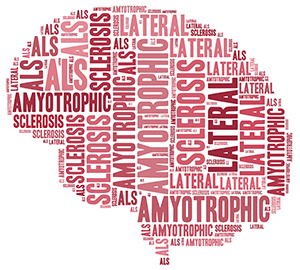
Author: Stefan Pulst

Scientists at University of Utah Health joined an international team of researchers on a project that identified a gene mutation that may be responsible for some sporadic and familial cases of Amyotrophic lateral sclerosis (ALS), commonly known as Lou Gehrig’s disease. The results are published in the March issue of Neuron.
ALS affects more than 20,000 Americans. This devastating neurodegerative disorder is characterized by progressive muscle weakness that eventually results in respiratory failure.
For about 10 percent of ALS patients, the disease can be traced through familial inheritance, but the majority are sporadic cases, caused by random gene mutations.
“When we talk about ALS, we should talk about plural ALS-es, because it is caused by many different gene mutations,” said Stefan Pulst, MD, professor and Chairman of Neurology at U of U Health and contributing author on the paper.
The researchers carried out a genome-wide association analysis (more than 20,000 ALS cases and 59,000 controls), as well as a rare variant burden analysis (more than 1,100 familial ALS cases and 19,000 controls) on samples obtained from institutions around the world, including U of U Health, to evaluate gene mutations that could play a role in the disease.
“KIF5A was a new gene that was shining through on both of these analytical approaches,” said Summer Gibson, MD, assistant professor of Neurology at U of U Health and contributing author on the paper. “It is incredibly exciting to see universities from across the world came together to contribute a large number of samples for the study to ensure that the mutations identified are not benign variants.”
The study showed that frame shift mutations on the KIF5A (Kinesin family member 5A) gene affects the assembly of proteins responsible for intracellular transport.
“KIF5A [proteins] moves stuff down the line in the cell,” said Gibson. “If debris gets stuck and builds up, it can produce toxic problems for that cell, which when the cell dies creates a toxic environment for the cells next door.”
In particular, these proteins transport neurofilaments that provide structural support for axons, the long thread-like part of a nerve cell that transmits impulses. The abnormal accumulation of neurofilaments in the cell contributes to motor neuron degradation.

The KIF5A mutation has previously been associated with other neurodegenerative diseases, like Charcot-Marie-Tooth disease and hereditary spastic paraplegia. For these conditions, the mutations affect how the gene assembles the beginning of the protein (N-terminal), but in ALS, the mutation affects how the gene builds the end of the protein (C-terminal).
This subtle difference is important because tinkering with the coding at the end of the protein results in weakness in the lower part of the body (commonly associated only with hereditary spastic paraplegia) as well as impairment of peripheral motor abilities, which migrates from the nerves outside the brain through the body affecting muscles, sensory organs, and limbs (commonly only associated with Charcot-Marie-Tooth disease).
Patients with the KIF5A mutation are often diagnosed with ALS at a younger age but can survive for more than 10 years, almost four times longer than ALS patients whose disease is caused by other genetic mutations.
While the results of this study identify a gene mutation that plays an important role in the development of ALS in some patients, the researchers caution that they cannot rule out other variants that could represent additional risk factors for disease formation or progression.
Future work is necessary to understand how KIF5A and other genetic mutations cause ALS in order to target the proper pathways to develop new therapies.
“We are looking for the holy grail,” Pulst said. “Each molecule we find gives us insight into why these nerves cells die and potential pathways to target to develop new therapies.”